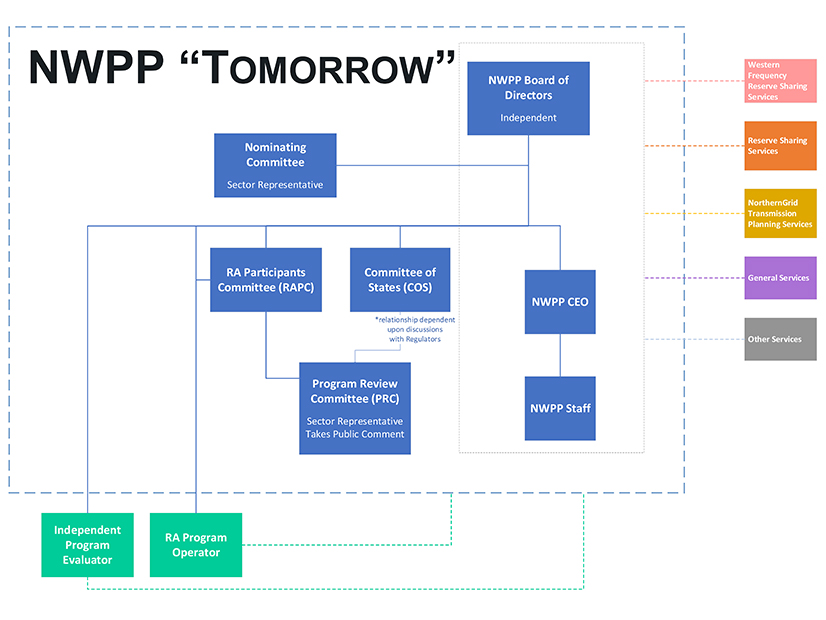
The Northwest Power Pool will have to radically restructure its governance to obtain FERC approval for its proposed resource adequacy program, group representatives said Wednesday.
“It is important to emphasize that we’re looking at a new role for the power pool that involves being the organization that hosts this program, and that involves a change to the power pool structure from what we have today,” Robb Davis, staff attorney with NWPP member Chelan County (Wash.) Public Utility District, said Wednesday during a Bonneville Power Administration meeting to discuss the RA program.
And the most significant change for the member-driven NWPP? The appointment of an independent board.
“We believe that will help with approval, and it may even be necessary that the board of directors will take on the role of hiring staff and hiring outside current contractors, like the program operator or independent evaluator,” Davis said.
NWPP has made steady progress on developing the RA program since kicking off the effort in early 2020, attracting interest from beyond the eight Western states and two Canadian provinces currently covered by the organization. That has prompted the group to rebrand, from the “NWPP RA Program” to the “Western Resource Adequacy Program provided by NWPP.”
“We’re discovering that there is a lot of interest in this program all the way to the Desert Southwest, and one of the things that was recommended is that we change it so that it’s more encompassing of the geographical area that we are representing — so we’ve done that,” NWPP COO Gregg Carrington said Wednesday.
NWPP began operating interim “light-touch” RA programs beginning last summer, which are designed to provide a “matching service” for entities either long or short in the electricity market. Participants have dipped into this summer’s program four times so far, Carrington noted, with most trades occurring during late June’s record-smashing heat wave in the Pacific Northwest.
In October, NWPP will launch a nonbinding, forward-showing program, a more relaxed phase of the market that will last through December 2022. The “forward showing” requires participants to demonstrate compliance with defined reliability metrics seven months ahead of RA seasons, but during the initial nonbinding period, participants will not be subject to penalties for coming up short of expected resources.
The penalty phase kicks in with the implementation of the binding program in January 2023, triggering the need for FERC to approve both the mechanics of the program and its governance.
Getting that approval will require the transformation of NWPP’s “semi-independent” board to one that is fully independent. The board will have the authority to approve budgets, provide organizational direction and set priorities.
More Committees
In a further attempt to ensure FERC’s approval before the binding program is rolled out, NWPP will establish a set of new stakeholder committees to beef up oversight of the RA program and the organization itself.
A proposed Nominating Committee — consisting of representatives from utilities, independent power producers, marketers, public interest groups and the states — will select board members. An RA Participant Committee will have “substantive authority” to amend the program and modify its rules, with changes subject to appeal to the board. A multisector Program Review Committee will be responsible for originating program changes.
And while its role is still being defined, a Committee of States will provide regulators a seat at the table. NWPP is working with the Western Interstate Energy Board and the Western Interconnection Regulatory Advisory Body to engage state regulators on the functions of that committee. “State buy-in and engagement for the regional RA program is critical to its success,” NWPP said.
“We saw in the Southwest Power Pool [Western Energy Imbalance Service] order this past year that FERC is open to [the committee design] approach,” Davis said. “We think we have an ability to justify the type of program we’re setting up, and we want to make sure that … what we’ve set up as an RA program stays in place, and we can get comfortable with operating in the in the framework that we’ve designed.”
Robb added that while participants will maintain “significant influence” over the program, the independent board “will always have ultimate authority.”
In addition to establishing clear board and committee oversight for the program, NWPP will also appoint an “independent evaluator” to analyze operations, settlements and program design — and to also recommend design changes. The body will not take on the role of a market monitor, nor will it wield any decisional authority.
NWPP earlier this month said it will contract with SPP to operate the RA program. The RTO had already been previously retained to design the program. (See SPP to Operate NWPP’s Resource Adequacy Program.)
NWPP hopes to file the governance changes with FERC next March.



